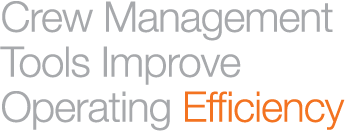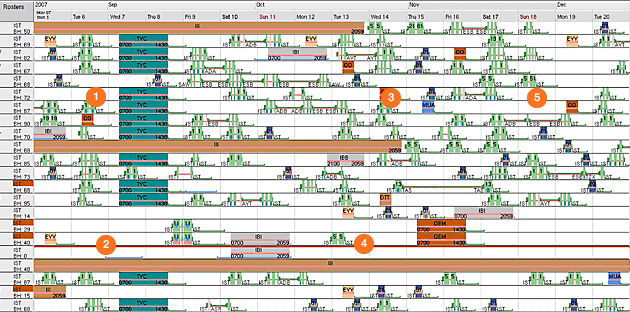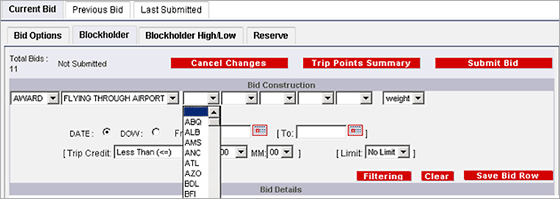
Frequent changes in airlines' market situations make it challenging to maintain efficient operations. This can lead to an underutilized fleet and crew, or even worse, a shortage of resources. Boeing subsidiary Jeppesen helps airlines overcome these challenges by enabling them to optimize crew utilization in terms of cost, robustness, and crew quality of life.
Airline operations have three major cost drivers: airplanes, fuel, and crew. Advanced mathematical models to optimize crew utilization were introduced in the early 1990s and have evolved continually since then. Key to the long-term success of such models is their adaptability to changes in planning conditions and their ability to absorb advancements in technology. Because of the large numbers of crew employed by major airlines, even small changes in productivity can have a significant impact on an airline’s profits: a single percent improvement can translate into several million dollars.
This article provides an overview of the crew management challenge that airlines face and illustrates the benefits of Jeppesen crew management software tools.
THE CREW MANAGEMENT CHALLENGE
Airlines want their crews to work as efficiently as possible within regulatory and contractual requirements. But an efficient plan also needs to be flexible enough to work under changes in real-world conditions. For example, it needs to easily accommodate the unexpected, such as sick crews or delayed flights.
What’s more, airline crews quite naturally want to influence their work content. Therefore, crew preferences are important inputs in the crew planning process. The crew planner also needs to monitor such items as crew fatigue, hotel costs, and standby requirements and deliver a crew plan that meets the airline’s objectives month after month.
Additional complications include implementation of a new crew agreement or an entire new fleet of airplanes. The result is that crew planners need to consider a wide array of information (see fig. 1).
Figure 1: Crew planning challenges
This crew management software computer screen shows the variety of often conflicting information crew planners must consider when assigning crews.

- 1 Classroom training
- 2 Day-off bid
- 3 Medical check
- 4 Minimum rest after duty
- 5 Simulator training
Jeppesen has developed a suite of software applications that streamlines crew management and automates the scheduling process (i.e., Carmen Crew Management). These tools help airlines manage dynamic flight schedules, crew member requirements, and complex logistical and contractual requirements. As a result, they deliver substantial savings in what usually is a major cost center for airlines. The following examples illustrate how airlines are using Jeppesen software tools.
Use case No. 1: Optimizing preferential biddingA major U.S. airline found its previous preferential bidding system inadequate because it left a large share of the flights unassigned and failed to meet contractual obligations with the pilot union. The airline’s new Jeppesen-based system offers a number of improvements:
- It enables full compliance with the contractual agreements by providing the ability to guarantee a crew group a minimum level of assignment, which corresponds to pay.
- It reduces the amount of open time (unassigned production) by nearly 30 percent. Because any open time left after crew roster publication must be covered by reserves, this provides real productivity improvements. In addition, the system levels the distribution of open time, reducing the biggest peak in open time by 50 percent. This also has a positive impact on productivity as a single reserve can take on only one duty at a time.
- It awards crews more of their bids than the previous system. It was most important to the airline that this was achieved for the more senior crew members, but the new system also resulted in an overall improvement in the bid award ratio of 14 percent.
One of the world’s fastest-growing airlines found its in-house solution for crew planning insufficient as it increased its revenue passenger kilometers (RPK) by about 20 percent per year for two consecutive years. The airline chose a more efficient Jeppesen solution to help it cope with its rapid growth.
In order to be operational with the system as quickly as possible, the airline and Jeppesen decided that Jeppesen would provide crew planning as a service while the software was being implemented. By using this approach, the airline could begin realizing savings within six weeks. The realized improvement in crew productivity was 12 percent.
After six months, the airline was running the system on its own. It also began using the new system’s scenario capability. A scenario may be a new schedule, new rules for how to schedule crew, revised costs, revised resource availability, or any combination. One of the most promising scenarios was to allow cabin crew to mix fleets in their rosters. This resulted in nearly 5 percent of additional efficiency improvements.
Use case No. 3: Streamlining a union agreementA planning system that is not visible to all of the parties involved is often perceived with skepticism by planners, management, and crew. In contrast, when all parties feel that they can control the system — rather than be controlled by it — the analytical power of the system can be leveraged effectively.
This was the case at an airline in a crisis when union agreement negotiations started. It was clear from the beginning that crew productivity needed to be improved; the question was how to achieve this improvement. The main obstacle to negotiations was an agreement that had grown to more than 200 pages through years of additions and modifications.
Because the changes that had been made over time resulted in an unnecessarily complicated agreement, the parties decided to take a fresh start, retaining only some fundamental rules and those related to regulatory issues. Then, in a brainstorming session, all ideas that were presented — good as well as bad — were implemented in the crew planning system and tested. Because the system was trusted by both parties, there was no dispute on whether the key performance indicators generated by the system were correct.
The result was a new union agreement that reduced crew costs by 15 to 20 percent. Such savings would not have been possible within the previous agreement without severely affecting crew pay. At the same time, the new union agreement went from 200 pages down to 15 pages. The agreement is seen as joint property by management and unions and is fully comprehensible by both parties. The system’s ability to allow for advanced simulations, combined with both parties’ trust in the system, facilitated a successful negotiation process.
SUMMARY
Jeppesen Carmen Crew Management optimization software provides fast, high-quality solutions for large crew populations, including complex problems with a high number of conflicting objectives. By improving the efficiency of assigning and managing airline crews, this software can help enhance overall airline operational efficiency.
For more information, please contact Tomas Larsson.

Pairing: A crew pairing is a sequence of flight legs from home base to home base. A pairing may cover one or many days. This is how a two-day pairing from Santiago to Rio de Janeiro via São Paulo and back is represented by Jeppesen crew management software.

Roster: A crew roster is a sequence of personal activities assigned to a crewmember. A roster contains not only pairings but also training, reserve duties, and other activities. Crew management typically provides rosters to crews monthly. Below is a depiction of a crewmember roster. The crewmember comes back from a sequence of ground activities. Those activities are followed by the crewmember traveling as a passenger from Dublin to Chicago, staying overnight, and flying back as an active duty. This is followed by three mandatory days off. Thereafter, the crewmember operates a roundtrip from Dublin with a layover in Boston.

Preferential bidding system: With this system, the crewmember bids for specific assignments. How this is done varies by airline. The crewmember may bid for pairings or for pairing properties, such as layover station, length of pairing, or check-in time. In almost all cases, the crewmember can bid for days off. In North America, bids are awarded based on seniority. In the rest of the world, some type of adjustment criteria is usually used. In this example, the crewmember is about to enter a request to get a pairing flying through a particular airport. The crewmember may also specify the length and dates of the stay.


